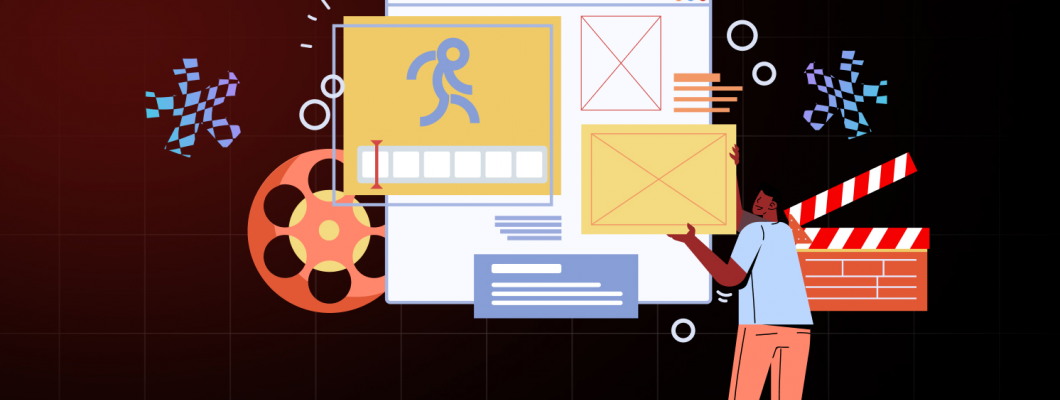
In today’s digital-first landscape, static websites no longer meet the expectations of modern users. People now crave interactive, visually engaging experiences that quickly grab their attention and communicate ideas effectively. This is where motion graphics shine. Originally seen in film and video, motion graphics have evolved to become essential elements in website design, enhancing both storytelling and user interaction. From subtle hover animations to full-screen motion-driven narratives, these visual effects bring life and depth to digital interfaces. They not only add aesthetic appeal but also serve functional purposes, guiding user actions, improving navigation, and reinforcing brand identity. By incorporating animated elements such as micro interactions, scroll-triggered effects, and logo transitions, designers can create experiences that are both intuitive and memorable.
Motion graphics do more than just decorate a page; they communicate complex ideas, foster emotional connections, and keep users engaged longer. As attention spans shrink, dynamic visuals become powerful tools for digital communication. This blog dives into how motion graphics are reshaping web design, the benefits they bring to the table, and key best practices to ensure they are implemented effectively without compromising speed or accessibility. Welcome to the future of web storytelling, where motion meets meaning.
What Are Motion Graphics?
Motion graphics are animated visual elements that combine graphic design with movement. Unlike full-blown animations or cinematic sequences, motion graphics typically include:
Text animations
Icon or logo transitions
Loading indicators
UI microinteractions
Scroll-triggered effects
Interactive visual storytelling
When thoughtfully integrated into web design, these elements can convey a brand's personality, guide user actions, and enhance the overall user experience.
Why Motion Graphics Matter in Web Design
1. Enhanced User Engagement
Motion grabs attention. From animated calls-to-action to dynamic background elements, motion graphics enhance the interactivity and visual appeal of websites. This increased engagement can lead to longer session durations, lower bounce rates, and higher conversion rates.
2. Improved Storytelling
Websites are not just digital brochures; they’re storytelling platforms. Motion graphics help tell your brand’s story in sequenced, digestible chunks. Animations can simulate a narrative flow, turning static messages into engaging experiences.
3. Better User Experience (UX)
Motion can also aid navigation and usability. Microinteractions such as button animations, loading states, or tooltips give users immediate feedback, making the interface feel more responsive and intuitive.
4. Visual Hierarchy and Focus
Animations can be used to draw attention to key messages or UI components. For instance, a slight motion effect can subtly guide the user’s eye toward a signup form or product demo, improving conversion opportunities.
Types of Motion Graphics in Web Design
1. Microinteractions
These are small animations that respond to user actions, like clicking a button, liking a post, or hovering over a link. They improve usability and provide visual feedback.
2. Animated Logos
An animated logo at the beginning of a homepage or during loading adds polish and memorably reinforces brand identity.
3. Scroll-Triggered Animations
These graphics animate based on the user’s scrolling behavior. They can help reveal information gradually, maintain focus, and simulate motion-based storytelling.
4. Data Visualization
Interactive charts and animated infographics present complex data in a visually engaging, easy-to-understand format. This is especially helpful in reports, case studies, or dashboards.
5. Hero Animations
Motion in the hero section of a homepage can set the tone for your entire website, highlighting products, features, or a brand mission in a dramatic, visual-first manner.
Tools for Creating Web Motion Graphics
If you’re considering adding motion to your website, here are some powerful tools to explore:
Lottie by Airbnb – Render animations in real time using lightweight JSON files.
Adobe After Effects – A popular tool for creating sophisticated motion designs.
Figma + Figmotion Plugin – Allows for simple motion design within your UI workflows.
GSAP (GreenSock Animation Platform) – A robust JavaScript library for high-performance animations.
Rive – A real-time interactive animation tool for responsive interfaces.
Best Practices for Using Motion Graphics
While motion graphics can be powerful, too much movement can overwhelm or distract users. Here are some best practices to ensure a smooth user experience:
1. Keep it Purposeful
Use motion to enhance function or storytelling, not just decoration. Ask: Does this animation improve usability or clarity?
2. Ensure Performance Optimization
Heavy animations can slow down your site, especially on mobile devices. Use lightweight formats like Lottie JSON, SVGs, and optimized GIFs.
3. Be Consistent
Maintain a consistent animation style across your site. Reuse transitions, easing curves, and durations to ensure a cohesive experience.
4. Offer Accessibility Options
Make sure animations are keyboard-navigable and screen-reader friendly, and offer users the option to reduce motion for better accessibility (via CSS prefers-reduced-motion media query).
5. Test Across Devices and Browsers
Different devices render motion differently. Test on both mobile and desktop, and ensure compatibility across major browsers to deliver a seamless experience.
Real-World Examples of Motion Graphics in Web Design
1. Apple
Apple’s website frequently uses motion to present products with fluid transitions, parallax effects, and cinematic storytelling, setting the standard for digital elegance.
2. Stripe
Stripe uses minimal motion to convey complex data and processes with clarity. Their animated illustrations and microinteractions make their developer-friendly platform approachable and engaging.
3. Spotify Design
Spotify’s microsites often use animated graphics and transitions to bring design case studies to life, using motion as a storytelling vehicle.
Conclusion: Bring Your Website to Life
Motion graphics are no longer an optional flourish they’re a critical component of modern web design. Whether you're looking to enhance user experience, tell your brand story, or simply make your site stand out, motion can help you achieve these goals with creativity and clarity.
But remember: the best motion graphics are purposeful, subtle, and aligned with your brand voice. By combining strategic design with interactive motion, you can create a website that doesn’t just look good it feels alive.

Leave a Comment